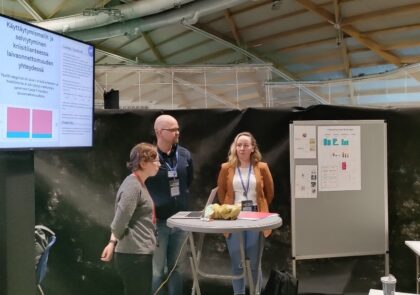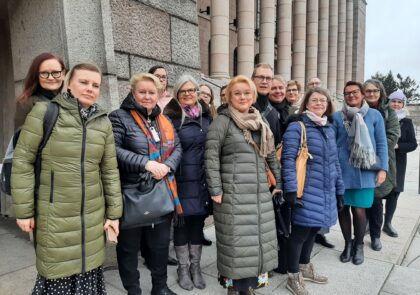
This article compiles findings from Circular Textiles thematic study conducted by the Interreg Europe funded project CECI – Citizen involvement in circular economy implementation project. This is the fourth article of the circular textiles series focusing on circular businesses around textiles.
Authors: Marjut Villanen, Katerina Medkova, Johanna Snell & Maarit Virtanen
According to EURATEX, the European Apparel and Textile Confederation, other relevant EU policies such as the EU Industrial strategy, the new EU Trade strategy, the EU Pact for Skills, the Sustainable Chemicals strategy, the Sustainable Product Initiative, etc. should be positioned with the new upcoming EU Strategy for textiles. It is important to synchronize European policies and remove counteractions. (EURATEX 2021.)
The Strategy for textiles will create a supportive and responsible environment for sustainable and circular textiles business in the EU, especially by delivering impulses to buttress product-as-service models, circular materials and production processes and international cooperation for increased transparency. The emphasis will be set on repair, reuse, easy disassembly and recycling. (European Commission 2021.)
CECI raises public awareness and supports the creation of sustainable services
The circular economy is expected to bring growth and business to regions and to strengthen their sustainable development goals. Citizen Involvement in Circular Economy Implementation, shortly CECI, is an Interreg Europe co-funded project that aims to improve regional policies with the emphasis on citizens role (Interreg Europe 2021). In CECI, interregional cooperation between six European regions (Finland, France, Czech Republic, Spain, Bulgaria, and Belgium) allows knowledge and practices exchange about different topics related to citizen involvement. Concrete examples inspire the adoption of tested solutions to other partner regions. (Interreg Europe 2021.)
Each CECI partner region has identified their own circular economy focus areas. One commonly recognized theme was sustainable textiles. CECI project has organized several online thematic workshops and good practices presentation meetings, in which also the regional project stakeholders have been present. The theme of textiles has been presented in these workshops and meetings. Each of these events included an active discussion with all partners and their stakeholders about regional textile collection and recycling, and the challenges related to these. The common outcome was, that although there are already existing good practices how a citizen can recycle textiles, there are also many common problems related especially to a collection and dispose of textiles. (Medkova & Villanen 2021.) For instance, in Finland, the Telaketju project has explored challenges connected with material recycling of textiles and published the National Collection of End-of-life Textiles in Finland instructions (Lounais-Suomen Jätehuolto 2021).
CECI project partners carried out a thematic study on circular textiles, which findings are outlined in a series of four articles in total. The first article focuses on the citizen’s role (Pichlova et al. 2021a), the second one pinpoints the importance of sustainable design and public procurement (Pichlova et al. 2021b), and the third article summarizes the legislation and the state of the art regarding textiles in CECI regions (Villanen et al. 2021).
New circular business opportunities and challenges
All the CECI project partners acknowledged some barriers or obstacles hindering the development and actions towards circular textiles. The lack of a functioning economic model was highlighted as a common barrier in all the project regions. Furthermore, identifying local opportunities and the complexity of textiles challenge the implementation of textiles circularity. The social acceptance of especially second-hand textiles also plays its role. The main challenge seems to be how to get citizens to use the new circular services and pay for them. Without enough demand, there will be no business opportunity. (CECI 2021.)
Textile reuse, for example, through charities is common in all CECI partner regions, but the quality of donated clothing is often too poor for resale. New clothes are cheap, while labour used to sort or upcycle clothes for reuse is more expensive than new raw materials and, therefore, the price of recycled products is higher. Material recycling is still undeveloped and difficult because of, for instance, the use of various materials and the lack of material reuse options. (CECI 2021.)
A possible solution for increasing circularity is extended producer responsibility (EPR) for textiles. EPR measures will be also regulated in the forthcoming EU Strategy for textiles (European Commission 2021). So far, only France has an EPR scheme for textiles, but also Sweden, UK and Spain are preparing legislation for it. Other actions that would speed up the transition include tax shifts, import taxation for virgin materials, minimum recycled content requirements and funding for the transition. (CECI 2021.)
Circular business opportunities can arise from new project ideas and collaboration born from discussions and cooperation with different groups. For instance, the CECI project partner from Mechelen works on launching a clothing library, swap shop or similar circular model for textile consumption. Finding relevant funding opportunities and attracting retailers in collaboration is underway. Intensive discussions, workshops and practical information exchange has already stimulated a policy improvement in the Päijät-Häme region, Finland. The policy improvement achieved is related to the implementation of a new project. Textiles into Circulation (Tekstiilit kiertoon) project aims to find solutions on how to organize the separate regional collection for disposable textiles, clarify the pre-treatment processes and logistics needed, and form a network between various regional actors to take care of the process in future. One of the project tasks is also to inform the residents about textile collection and recycling and to activate citizens to separate their disposable textiles correctly. (CECI 2021; LAB 2021.)
Conclusion
The textiles’ future looks promising. There are many arising technologies, business ideas and new demands coming from responsible consumers. Interregional knowledge exchange is an important tool to disseminate good practices and inspire more actors to jointly accelerate the transition towards sustainable consumption, recovery and circular textiles.
References
CECI. 2021. CECI Thematic study II survey. Unpublished.
EURATEX. 2021. A New EU Strategy for Textiles & Clothing: EURATEX Vision. [Cited 22 Oct 2021]. Available at: https://euratex.eu/wp-content/uploads/EURATEX-Vision-on-EU-Textile-Strategy-fin.pdf
European Commission. 2021. Strategy for textiles. Internal Market, Industry, Entrepreneurship and SMEs. [Cited 22 Oct 2021]. Available at: https://ec.europa.eu/growth/industry/sustainability/textiles_en
Interreg Europe. 2021. Project Summary. CECI. [Cited 23 Sep 2021]. Available at: https://www.interregeurope.eu/ceci/
LAB. 2021. Textiles into circulation. [Cited 23 Sep 2021]. Available at: https://lab.fi/en/project/textiles-circulation
Lounais-Suomen Jätehuolto. 2021. National Collection of End-of-life Textiles in Finland [Cited 22 Oct 2021]. Available at: https://telaketju.turkuamk.fi/uploads/2020/08/0c08d295-national-collection-of-end-of-life-textiles-in-finland_lsjh.pdf
Medkova, K. & Villanen, M. 2021. Towards Circular Textiles. [Cited 22 Oct 2021]. Available at: https://blogit.lab.fi/labfocus/en/towards-circular-textiles/
Pichlova, A., Delaunay-Belleville, A., Villanen, M & Medkova, K. 2021a. Involving citizen in textile recycling. LAB Pro. [Cited 22 Oct 2021]. Available at: https://www.labopen.fi/lab-pro/involving-citizen-in-textile-recycling/
Pichlova, A., Delaunay-Belleville, A., Villanen, M & Medkova, K. 2021b. Sustainability all the way from design and public procurement into recycling. LAB Pro. [Cited 22 Oct 2021]. Available at: https://www.labopen.fi/lab-pro/sustainability-all-the-way-from-design-and-public-procurement-into-recycling/
Villanen, M. Medkova, K., Snell, J. & Virtanen, M. 2021. Focusing on steps towards sustainable textiles. LAB Pro. [Cited 22 Oct 2021]. Available at: https://www.labopen.fi/lab-pro/focusing-on-steps-towards-sustainable-textiles/
Authors
Marjut Villanen works as an RDI specialist at LAB University of Applied Sciences and is the CECI Project Manager.
Katerina Medkova works as an RDI specialist at LAB University of Applied Sciences and is the CECI Communication Manager.
Johanna Snell, a CECI project coordinator in the Regional Council of Päijät-Häme.
Maarit Virtanen, a Climate Specialist at the Regional Council of Päijät-Häme.
Illustration: https://www.pexels.com/fi-fi/kuva/muoti-naine-luova-suunnittelija-3811855/ (Pexels Licence)
Published 3.11.2021
Reference to this article
Villanen, M., Medkova, K., Snell, J. & Virtanen, M. 2021. Circular textiles require circular businesses. LAB Pro. [Cited and date of citation]. Available at: https://www.labopen.fi/lab-pro/circular-textiles-require-circular-businesses/






